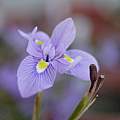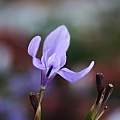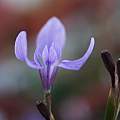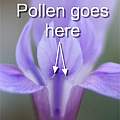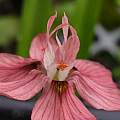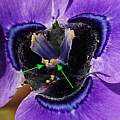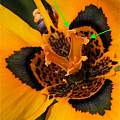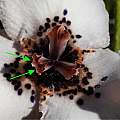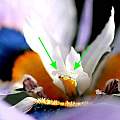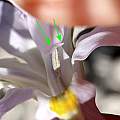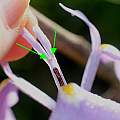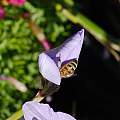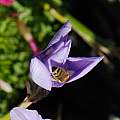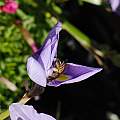Whether you grow species or hybrid Moraea plants, it's useful to know how to pollinate them.
The two parts of the Moraea flower that you need to find are the anthers (the things that hold the pollen) and the stigmas (the places where you put the pollen). In general, there are three anthers in every Moraea flower, and three pairs of stigmas (or stigmatic lips, as I've sometimes seen them called, because they look a bit like tiny lips or flaps). Here's a diagram of a typical Moraea flower:
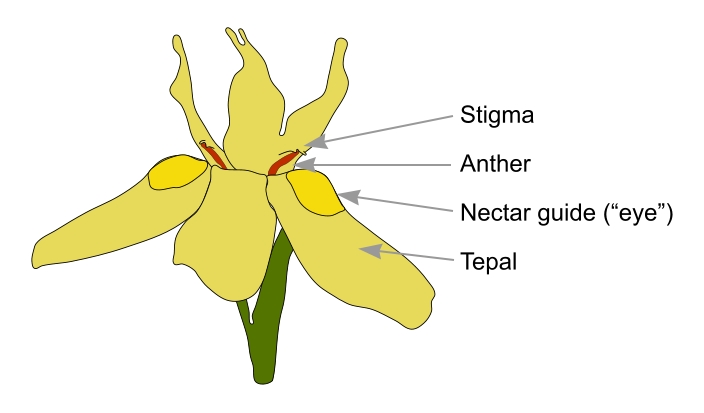
There's often a contrasting color spot on the flower that tells a pollinating insect where to go (the botanists call it a nectar guide; I call it an eye for short). On the flower surface facing the eye you'll find the anther, which is usually a contrasting color and easy to spot because it has pollen on it (once the flower is fully open). Just above the tip of the anther are two little flaps of tissue. These are the stigmas. Usually they are not a contrasting color, and they may be hard to spot. You want to put the pollen on the inside of those flaps.
Sometimes the flaps may be stuck to the surface of the flower. If needed, you can pry them open with a very small camel's hair brush.
For a presentation, I once dissected a Moraea polystachya flower and photographed the parts. I felt like a barbarian, but it was in the name of education, OK?
The first photo shows the poor unsuspecting flower before surgery. In the second photo, I have pulled off the outer tepals (if you're an iris grower, you call these the falls).* The anther is the dark purple vertical strip in the middle. It hasn't opened yet, so you don't see any pollen on it. In the third photo, the anthers have been removed using tweezers. The fourth photo is a closeup of the stigmas.
These are pollination photos of some other Moraea species. In the first photo, a flower of Moraea gawleri has been pollinated. The pollen is bright orange, so it's easy to spot. In Moraea gigandra (second photo), the stigmas are at the outer end of the central crest (this flower has been pollinated with orange pollen). In Moraea neopavonia / tulbaghensis (third photo), the stigmas are small horn-like flaps at the end of the central crest. These have been pollinated. In Moraea atropunctata (fourth photo), the stigmas are near the outer end of the crest. Photos 5-7 by M. Gastil-Buhl show the stigmas for Moraea villosa, M. fugax, and M. tripetala. The stigmas in M. tripetala are especially tiny, and you have to pull up the crest of the flower to expose them.
How to transfer the pollen. I like to use a small camel's hair brush; others favor a cotton swab. Or you can just use tweezers to rip off the anther and rub it on the stigma of the target flower.
If the flowers you need to cross do not bloom at the same time, you can store pollen in the freezer. I use small plastic film canisters for storage. If you live in a humid climate, putting some dessicant in the container is probably a good idea.
In my garden, most Moraea species usually don't self-pollinate. In some species, the anther curls up and over the stigma, spreading pollen all over the place. I used to focus on removing the anthers from these flowers before the flowers could self-pollinate, but after some tests I realized that most of the species I grow are not self-fertile anyway. They need pollen from another individual to set seed, so all you have to worry about is bees and other insects (see below).
Watch out for bees. If you're serious about breeding Moraeas, you'll need to be careful about accidental pollination. It's no fun to grow seedlings for three years only to discover that they were pollinated by a bee with the wrong pollen.
In my garden in California, honeybees are attracted to the purple Moraeas (Moraea polystachya and M. villosa in particular). Moraea gigandra attracts bees, but the shape of the flower doesn't cause pollination. Moraea lurida attracts house flies and is pollinated by them. The white and orange Moraeas are generally not bothered by bees.
The bees can be very aggressive with flowers they like. In the photo sequence below, a bee is forcing open a flower of M. polystachya. In the process of fighting its way in there, it will spread pollen all over the place.
If you want to make a protected cross, you can either invest in making a screened cage, or pull off the outer tepals of the flower as it first opens (as illustrated in the dissection example above). Without the outer tepals in place, the bees have no place to land, and the flower does not get pollinated.
Usually, because I'm lazy, I do not bother to pull off the tepals. I just make sure I pollinate a flower before any bees get to it. I figure my pollen will probably dominate if it gets in there first, and I use a lot of it. A truly professional breeder would be appalled.
Article by Michael Mace.
_________
*If you're familiar with Iris terminology, the following translation table may be helpful:
| Iris growers call it | Moraea growers call it |
| Fall | Outer tepal |
| Standard | Inner tepal |
| Signal | Nectar guide (eye) |
| Style | Style |
| Crest | Crest |
Galaxia - Gynandriris - Hexaglottis - Homeria A-J - Homeria K-Z - Moraea group A - Moraea group B - Moraea group C-E - Moraea group F - Moraea group G-I - Moraea group J-M - Moraea group N-R - Moraea group S - Moraea group T - Moraea group U-V - Moraea index
